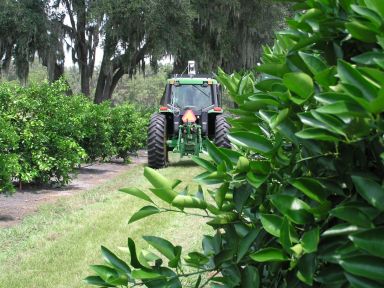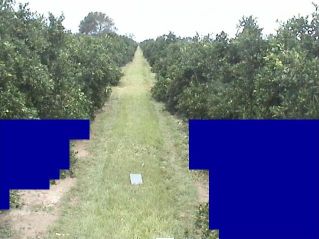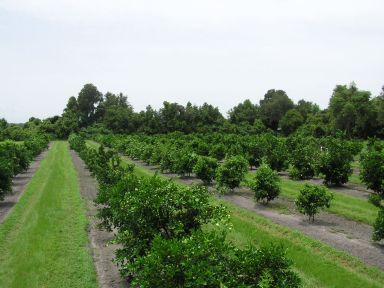Home About Research Projects Publications Classes Interests
Autonomous Tractor

This research is aimed at developing an autonomous tractor capable of
navigating the alleyways end to end of a citrus orchard. The work was
started in 2003 and was continued till 2006. The
vehicle is expected to be operated in harsh outdoor environments. A
tractor was a good platform to begin this research. (Pic: Tractor in grove with camera mounted on top)
 The
tractor uses hydraulic circuits for steering. To operate autonomously,
computer control is essential. Therefore to interface electrical and
hydraulic circuits, an electro-hydraulic servo valve was added to the
vehicle. However, manual controls could not be sacrificed, as the
vehicle needs to be moved from the lab to the orchard frequently for
testing. Therefore a separate hydraulic circuit was retrofitted in
parallel with the manual circuit. (Pic: Driver's view)
The
tractor uses hydraulic circuits for steering. To operate autonomously,
computer control is essential. Therefore to interface electrical and
hydraulic circuits, an electro-hydraulic servo valve was added to the
vehicle. However, manual controls could not be sacrificed, as the
vehicle needs to be moved from the lab to the orchard frequently for
testing. Therefore a separate hydraulic circuit was retrofitted in
parallel with the manual circuit. (Pic: Driver's view)
 For
awareness of the environment, a color video camera and a laser radar
were mounted on the roof of the tractor cabin. The video was used to
run the computer vision program to recognize objects and the laser
radar was used to get the range of the objects. An inertial measurment
unit/gyroscope was fixed to the tractor to measure the tilt and heading
of the vehicle during operation. This tilt and heading information is
used to modify the information obtained from vision to compensate for
tilt. An ultrasonic speed sensor feeds back speed to the computer. A
rotary encoder keeps track of the steering angle. (Pic: Vision algorith)
For
awareness of the environment, a color video camera and a laser radar
were mounted on the roof of the tractor cabin. The video was used to
run the computer vision program to recognize objects and the laser
radar was used to get the range of the objects. An inertial measurment
unit/gyroscope was fixed to the tractor to measure the tilt and heading
of the vehicle during operation. This tilt and heading information is
used to modify the information obtained from vision to compensate for
tilt. An ultrasonic speed sensor feeds back speed to the computer. A
rotary encoder keeps track of the steering angle. (Pic: Vision algorith)
 The
sensors are interfaced to the computer. The vision program identifies
trees, the path for the vehicle and unknown objects in front of the
vehicle. The laser radar program determines the distance of these
objects from the tractor. Based on these information, the center of the
path is determined while also avoiding unknown objects. A fuzzy
logic enhanced kalman filter fuses the information from all the sensors
to get a more reliable information than while using individual sensors
and also to remove noise in the sensors. The position of the vehicle
with respect to where it should be is sent to a microcontroller. (Pic: Test path for development)
The
sensors are interfaced to the computer. The vision program identifies
trees, the path for the vehicle and unknown objects in front of the
vehicle. The laser radar program determines the distance of these
objects from the tractor. Based on these information, the center of the
path is determined while also avoiding unknown objects. A fuzzy
logic enhanced kalman filter fuses the information from all the sensors
to get a more reliable information than while using individual sensors
and also to remove noise in the sensors. The position of the vehicle
with respect to where it should be is sent to a microcontroller. (Pic: Test path for development)
 A
PID controller is programmed in the microcontroller. The controller
steers the vehicle to keep the vehicle in the middle of the path.
A
PID controller is programmed in the microcontroller. The controller
steers the vehicle to keep the vehicle in the middle of the path.
(Pic: Orchard where tests were conducted)
Video

About Research Projects Publications Classes Interests


 The
tractor uses hydraulic circuits for steering. To operate autonomously,
computer control is essential. Therefore to interface electrical and
hydraulic circuits, an electro-hydraulic servo valve was added to the
vehicle. However, manual controls could not be sacrificed, as the
vehicle needs to be moved from the lab to the orchard frequently for
testing. Therefore a separate hydraulic circuit was retrofitted in
parallel with the manual circuit. (Pic: Driver's view)
The
tractor uses hydraulic circuits for steering. To operate autonomously,
computer control is essential. Therefore to interface electrical and
hydraulic circuits, an electro-hydraulic servo valve was added to the
vehicle. However, manual controls could not be sacrificed, as the
vehicle needs to be moved from the lab to the orchard frequently for
testing. Therefore a separate hydraulic circuit was retrofitted in
parallel with the manual circuit. (Pic: Driver's view) For
awareness of the environment, a color video camera and a laser radar
were mounted on the roof of the tractor cabin. The video was used to
run the computer vision program to recognize objects and the laser
radar was used to get the range of the objects. An inertial measurment
unit/gyroscope was fixed to the tractor to measure the tilt and heading
of the vehicle during operation. This tilt and heading information is
used to modify the information obtained from vision to compensate for
tilt. An ultrasonic speed sensor feeds back speed to the computer. A
rotary encoder keeps track of the steering angle. (Pic: Vision algorith)
For
awareness of the environment, a color video camera and a laser radar
were mounted on the roof of the tractor cabin. The video was used to
run the computer vision program to recognize objects and the laser
radar was used to get the range of the objects. An inertial measurment
unit/gyroscope was fixed to the tractor to measure the tilt and heading
of the vehicle during operation. This tilt and heading information is
used to modify the information obtained from vision to compensate for
tilt. An ultrasonic speed sensor feeds back speed to the computer. A
rotary encoder keeps track of the steering angle. (Pic: Vision algorith) A
PID controller is programmed in the microcontroller. The controller
steers the vehicle to keep the vehicle in the middle of the path.
A
PID controller is programmed in the microcontroller. The controller
steers the vehicle to keep the vehicle in the middle of the path. 